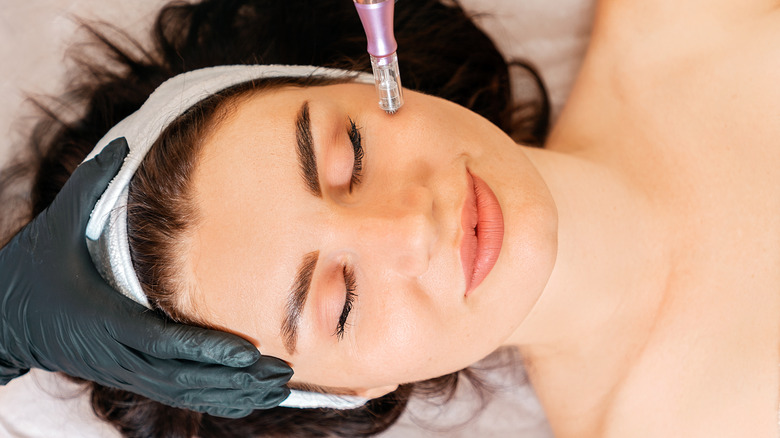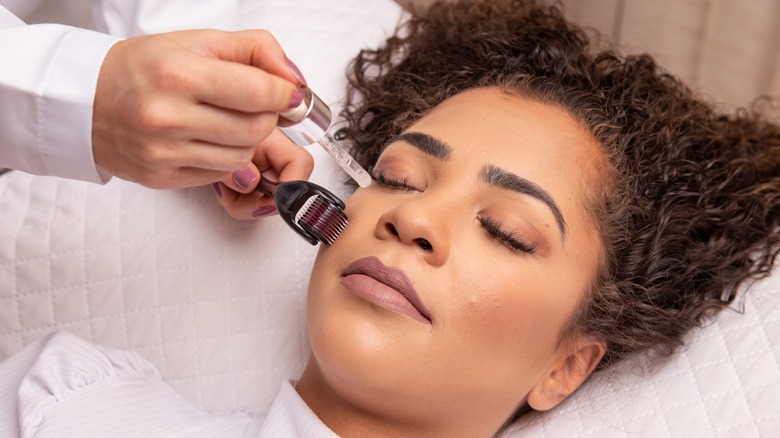Can Microneedling Actually Make Your Wrinkles Worse?
Microneedling is one of the most popular procedures people use to make their skin bright, tight, and wrinkle-free. Many love it because it's minimally invasive and pretty cost-effective compared to more expensive treatments, such as laser skin resurfacing. Microneedling is just like it sounds — it involves tiny needles that puncture the skin to stimulate collagen production.
While there are many at-home devices people can use, according to the American Academy of Dermatology Association, seeing a trained physician or dermatologist is wiser. The doctor will use sterile needles to puncture the surface of the skin just enough to cause light bleeding. The skin may be red for a few days to a week, and board-certified dermatologist Tina Alster advises patients to stay out of the sun following the procedure.
The procedure may be uncomfortable and slightly painful, but many think it's worth it. Microneedling is known to improve the appearance of acne scars and dark spots, while also minimizing pores. It can also reduce the appearance of wrinkles and fine lines, which is the ultimate skin goal. However, in some cases, microneedling may have an adverse effect and can cause wrinkles to appear worse.
Microneedling can cause short-term wrinkling
Many turn to microneedling to make their skin appear smoother and younger, but sometimes it can have the opposite effect. Some patients may see wrinkles develop after the procedure, but the Needling Guide states that it may be due to transepidermal water loss, also known as TEWL, and is only temporary. As MT Dermaroller explains, microneedling causes the skin to lose water due to the needles piercing the skin and damaging the cells. Following the treatment, the skin can appear dry, which may cause temporary wrinkles. To combat this, you should moisturize the skin sufficiently.
Patients that see increased wrinkling over time may suffer from glycation, which occurs when there is excess glucose in skin fibers, per ISDIN. The excess glucose cause sugar molecules to attach to collagen and elastin in one's body, which can lead to less youthful-looking skin. However, microneedling doesn't cause glycation and is just the body's natural reaction to aging.
Most people do see an improvement in their skin after microneedling and believe the rewards outweigh the risks. However, there are some caveats you should be aware of before your treatment.
Other risks of microneedling
Microneedling is a safe procedure with minimal risks and a short healing period. Many people experience some redness and swelling for a few days after their procedure. However, it's not as simple as waltzing into a dermatologist's office on a whim. There are some rules patients must adhere to ensure a safe and effective treatment. Prior to your appointment, you shouldn't have any inflammation or infections on the skin, Eternal Dermatology + Aesthetics advises. Those who have skin conditions like eczema or rosacea are not good candidates for microneedling, as well as people on blood thinners.
Besides possible temporary wrinkling, other short-term risks of microneedling include bruising and peeling, per WebMD. A long-term risk can be scarring, and those who are prone to keloids, which are bumpy scar tissue, should avoid microneedling. A more serious concern is a possible infection, since microneedling causes breakage in the skin. Therefore, it's best to go to a respectable dermatologist or aesthetician who practices clean safety measures. Despite the minimal risks, the consensus seems to be that microneedling is a great option for a more youthful appearance and it continues to be a popular skincare trend.


